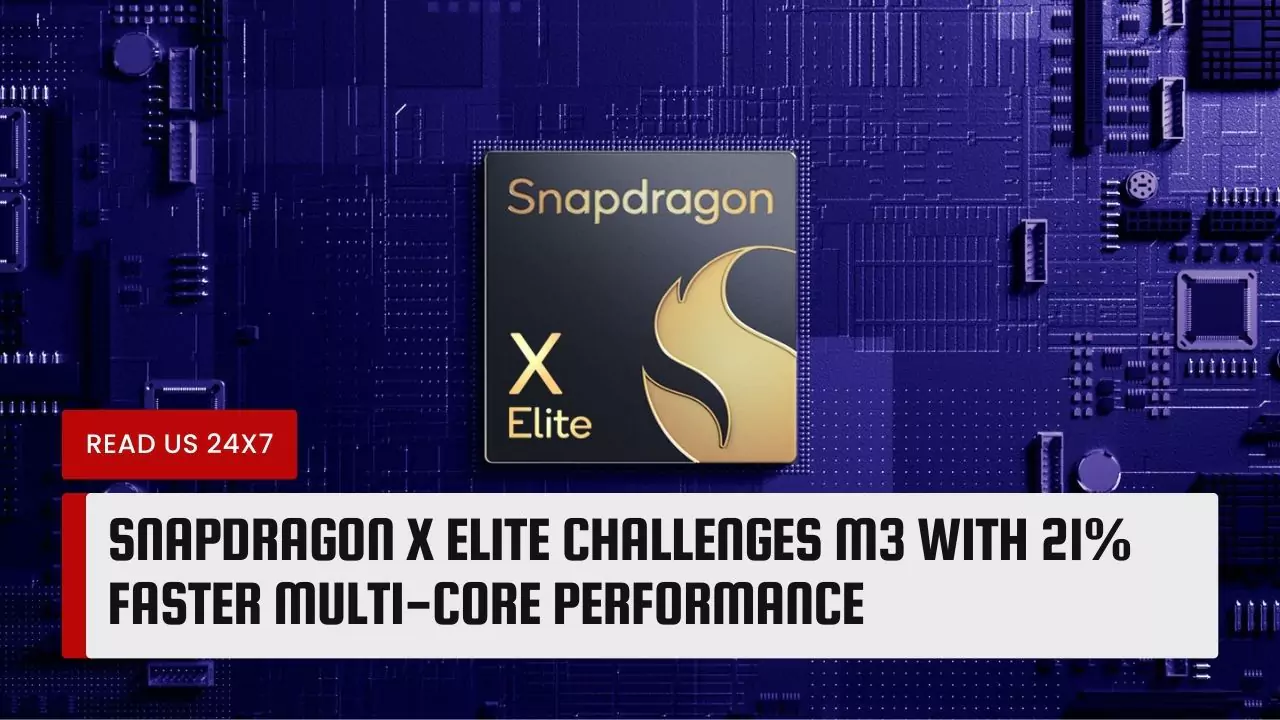Qualcomm has announced its latest flagship processor, the Snapdragon X Elite, which claims to outperform Apple’s M3 chip in both single-core and multi-core performance. The Snapdragon X Elite is designed for high-end laptops and tablets and aims to compete with Intel and AMD processors in the PC market. In this article, we will examine Qualcomm’s claims, the features of the Snapdragon X Elite, and how it compares with Apple’s M2 and M3 processors.
Qualcomm’s Claims About the Snapdragon X Elite
Qualcomm claims that the Snapdragon X Elite is 21% faster than Apple’s M3 chip in multi-core performance, based on Geekbench 6 scores. The Snapdragon X Elite has a score of 15,300, while the M3 has a score of 12,154.
Apple M3 runs at a higher single-core speed of 4.05 GHz, resulting in a Geekbench score of 2,780 for Snapdragon X Elite versus 3,163 for Apple, favoring Apple’s M3.
Qualcomm says that the Snapdragon X Elite delivers “unmatched multi-threaded performance” on Geekbench 5, which measures the performance of multiple cores working together. Qualcomm says that this is important for tasks such as video editing, gaming, and multitasking.
Qualcomm also says that the Snapdragon X Elite is designed to compete with Intel and AMD processors in the PC market, which have traditionally dominated the laptop and tablet segment. Qualcomm says that the Snapdragon X Elite offers “the best performance per watt” and “the best performance per dollar” among its competitors.
Features of the Snapdragon X Elite
The Snapdragon X Elite is based on a 5-nanometer process, which means that it has smaller and more efficient transistors than older processors. The Snapdragon X Elite has eight cores, four of which are high-performance cores, and four of which are power-efficient cores. The high-performance cores can run at up to 3.2 GHz, while the power-efficient cores can run at up to 1.8 GHz.
The Snapdragon X Elite also has a powerful GPU, the Adreno 730, which can handle graphics-intensive tasks such as gaming and rendering. The Adreno 730 supports DirectX 12, Vulkan, and OpenCL, which are popular APIs for graphics programming.
The Snapdragon X Elite also has AI capabilities, which can enhance the user experience and performance of applications. The Snapdragon X Elite has a Hexagon 790 DSP, which can perform up to 26 trillion operations per second (TOPS) of AI processing. The Snapdragon X Elite also has a Tensor Accelerator, which can perform up to 15 TOPS of AI processing.
The Snapdragon X Elite also has Wi-Fi integration, which means that it has a built-in Wi-Fi 6E chip, which can provide faster and more reliable wireless connectivity. The Snapdragon X Elite also supports Bluetooth 5.2, which can enable low-latency audio and data transmission.
Comparison with Apple’s M2 and M3 Processors
Apple’s M2 and M3 processors are also based on a 3-nanometer process and have eight cores, four of which are high-performance cores, and four of which are power-efficient cores. The M2 and M3 processors have similar peak multi-threaded performance as the Snapdragon X Elite, with Geekbench 5 scores of 10,000 and 8,250, respectively.
However, there are some differences between the Snapdragon X Elite and the M2 and M3 processors in terms of CPU power draw and thermal design power (TDP). The CPU power draw is the amount of power that the CPU consumes when running at full speed, while the TDP is the amount of heat that the CPU can dissipate without throttling.
The Snapdragon X Elite has a CPU power draw of 15 watts, while the M2 and M3 processors have a CPU power draw of 10 watts and 18 watts, respectively. This means that the Snapdragon X Elite consumes more power than the M2, but less power than the M3 when running at full speed.
The Snapdragon X Elite has a TDP of 25 watts, while the M2 and M3 processors have a TDP of 15 watts and 30 watts, respectively. This means that the Snapdragon X Elite can dissipate more heat than the M2, but less heat than the M3, without throttling.
The impact of TDP on performance depends on the cooling system of the device. A device with a higher TDP can run faster for longer, but it also requires a more efficient cooling system to prevent overheating. A device with a lower TDP can run cooler and quieter, but it also may throttle more often to avoid exceeding the thermal limit.
Therefore, the performance of the Snapdragon X Elite, the M2, and the M3 processors may vary depending on the device they are installed in, and the workload they are running. The Snapdragon X Elite may have an advantage over the M2 and the M3 processors in some scenarios, but it may also have a disadvantage in others.



